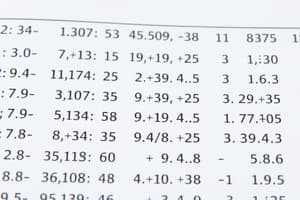Podcast
Questions and Answers
What is the main purpose of the Chi-Square Goodness of Fit test?
What is the main purpose of the Chi-Square Goodness of Fit test?
- To test the fit of observed frequencies to a theoretical distribution (correct)
- To compare means between two groups
- To determine the correlation between two variables
- To estimate population parameters
Which assumption must be met for the Chi-Square Goodness of Fit test?
Which assumption must be met for the Chi-Square Goodness of Fit test?
- The data must come from a random sample (correct)
- The sample size must be at least 30
- The data must be normally distributed
- The samples must be independent
What is the null hypothesis in a Chi-Square Goodness of Fit test?
What is the null hypothesis in a Chi-Square Goodness of Fit test?
- The data are normally distributed
- There is a significant difference between the means of two groups
- The observed frequencies fit the expected frequencies (correct)
- The observed frequencies do not fit the expected frequencies
Which is a requirement for the expected frequency in each category in a Chi-Square Goodness of Fit test?
Which is a requirement for the expected frequency in each category in a Chi-Square Goodness of Fit test?
Which of the following statements describes the alternative hypothesis (H1) in a Chi-Square Goodness of Fit test?
Which of the following statements describes the alternative hypothesis (H1) in a Chi-Square Goodness of Fit test?
When calculating the chi-squared statistic, which component represents the expected frequency?
When calculating the chi-squared statistic, which component represents the expected frequency?
What is the formula to calculate the degrees of freedom (df) in the chi-squared test?
What is the formula to calculate the degrees of freedom (df) in the chi-squared test?
Which Google Sheets formula is used to obtain the P-value in a chi-squared test?
Which Google Sheets formula is used to obtain the P-value in a chi-squared test?
What is the expected frequency when all expected frequencies are equal and there are 50 observations across 10 categories?
What is the expected frequency when all expected frequencies are equal and there are 50 observations across 10 categories?
Which term in the chi-squared formula represents the observed frequency?
Which term in the chi-squared formula represents the observed frequency?
What is the significance level in the Google Sheets formula to obtain the critical value of the chi-squared test?
What is the significance level in the Google Sheets formula to obtain the critical value of the chi-squared test?
Flashcards are hidden until you start studying
Study Notes
Chi-Square Goodness of Fit Test
- The Chi-Square Goodness of Fit test is a statistical method used to determine if a set of observed frequencies fits a specific theoretical distribution.
- The test is used to determine if there is a significant difference between the observed frequency distribution and the theoretical distribution.
- If there is no significant difference, it is said that the observed frequencies fit the expected frequencies.
Hypotheses
- The null hypothesis (HO) states that the observed frequencies fit the expected frequencies.
- The alternative hypothesis (H1) states that the observed frequencies do not fit the expected frequencies.
- Hypotheses must be stated in a relevant manner for each specific problem.
Assumptions
- The data must be obtained from a random sample.
- The expected frequency for each category must be 5 or more.
Chi-Squared Test Formula
- The chi-squared test statistic is calculated as: χ² = ∑[(Oi - Ei)² / Ei], where Oi is the observed frequency and Ei is the expected frequency.
Degrees of Freedom
- The degrees of freedom (df) is calculated as: df = n - 1, where n is the number of observations.
Critical Value
- The critical value is obtained using the Google Sheets formula: =CHISQ.INV.RT(α, df), where α is the significance level and df is the degrees of freedom.
P-Value
- The P-value is obtained using the Google Sheets formula: =CHISQ.DIST.RT(x², df), where x² is the calculated chi-squared statistic and df is the degrees of freedom.
Calculating Expected Frequencies
Equal Expected Frequencies
- When all expected frequencies are equal, the expected frequency (E) is calculated as: E = n/k, where n is the total number of observations and k is the number of categories.
Unequal Expected Frequencies
- When the expected frequencies are not equal, the expected frequency (E) is calculated as: E = n * p, where n is the total number of observations and p is the probability for that category.
Studying That Suits You
Use AI to generate personalized quizzes and flashcards to suit your learning preferences.




